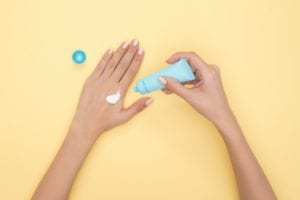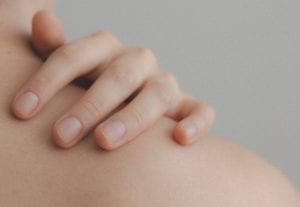Cancer recovery and making a comeback
Cancer Recovery Journey A Personal note from Krista, founder of

Scence Co-Founders
What is non toxic skincare? Do you read your personal care and make up labels like you would your food labels and apply the same principles?
How are you kicking off 2023? January has become the customary month to challenge ourselves to abstain from things we deem to be unhealthy with a strong focus on detoxing our bodies internally. Don’t get me wrong, I’m all in for a healthier start to the new year and undoubtedly feel the positive effects of refraining from booze and being more mindful of the foods I consume. However, do we really consider the accumulative effects of the toxins that we not only consume but repetitively douse ourselves with externally? So, what are we talking about… make-up, lotions, potions, deodorant, perfume, etc, etc, all of which sit on our skin for hours on end. Do we really ever ask ourselves, how toxic is my skincare?

Now I’m not suggesting that you give this up and leave the house smelling and looking frightful, on the contrary. I’m suggesting we consider the pernicious effects these products have on our bodies with the same gravity as alcohol, smoking and animal products. We tend to carefully analyse the ingredients, the origin and the sustainability aspect of the foods and beverages we consume to nourish our bodies but do we apply the same attention and ethics to the products we use externally. I’m not sure we do, we tend to trust these companies and not examine too closely the dubious and often highly toxic chemicals in our personal care and cosmetics, let’s face it, cosmetic ingredients can be tricky to decipher. So, here’s just a handful of chemicals that make a regular appearance in our personal care often given a completely different name (INCI jargon) – hydroquinone, mercury, arsenic, aluminium, petroleum, formaldehyde, propylene glycol, phthalates, parabens, synthetic fragrances and colours, Triclosan – to name a few. These chemicals can be absorbed by the skin and cause serious problems like neurotoxicity, organ system toxicity, allergic reactions, endocrine disruption, lung toxicity and many more grave health conditions.
I think many of us have fallen prey to beauty propaganda, in an age of digital media we’re bombarded with the latest trending “must haves”, buying products endorsed by our favourite and trusted celebrity or influencer (who are rewarded with vast amounts of money by the way) driving fallacious sales, promising the world only to deliver a rash, or a disappointing nothing.

So, what’s the simple answer?
Stop buying and using this junk. You’re the answer, you have the power. Actively seek out non toxic skincare, and cosmetics not tested on animals. Clean beauty products that are safe for pregnancy, sensitive skin, rosacea and acne. Halal skincare (alcohol free cosmetics) – and since we are in Veganuary – check out products with Vegan cosmetic certification as this cruelty-free accreditation process is rigorous and carefully regulated. Find safe skincare that you would be happy to share with your teenage kids.
Education and informed choices are the future to disrupt this misleading multi-billion-pound industry.
Also, don’t be fooled by the word “organic”. It’s easy to assume it’s a good choice, but unfortunately this does not mean natural and is a very clever personal care greenwashing buzz word. Organic versus natural is a subject close to my heart and I will be talking more about this in the coming months.
Meanwhile, I urge you to choose independent non toxic beauty brands. Companies that are transparent and ethical and only use natural ingredients. There are a wealth of options out there that formulate superior, clean cosmetic products with proven efficacy, so you never need to compromise.
Below is a useful table of ingredients from ewg.org which is a great independent resource to find out more.
| Chemical Name | Function | Used In | Possible Health Problems | Synonyms |
| Parabens
|
Butylparaben is in the paraben family of preservatives used by the food, pharmaceutical, and personal care product industries. Parabens mimic oestrogen and can act as potential hormone (endocrine) system disruptors.
|
shampoos, conditioners, body washes, and moisturiser’s, make -up
|
OTHER CONCERNS
Use restrictions (moderate), Endocrine disruption (high), and Biochemical or cellular level changes (moderate) |
4-HYDROXY- BUTYL ESTER BENZOIC ACID, 4-HYDROXYBENZOIC ACID, BUTYL ESTER, SODIUM SALT, BENZOIC ACID, 4-HYDROXY-, BUTYL ESTER, BENZOIC ACID, 4-HYDROXY-, BUTYL ESTER, SODIUM SALT, BENZOIC ACID, 4HYDROXY, BUTYL ESTER, BUTYL 4-HYDROXYBENZOATE, BUTYL ESTER BENZOIC ACID, 4-HYDROXY-, BUTYL ESTER SODIUM SALT 4-HYDROXYBENZOIC ACID, BUTYL ESTER SODIUM SALT BENZOIC ACID, 4-HYDROXY-, BUTYL P-HYDROXY BENZOATE, BUTYL P-HYDROXYBENZOATE, BUTYL PARAHYDROXYBENZOATE, BUTYLPARABEN, BUTYLPARABEN, POTASSIUM SALT, BUTYLPARABEN, SODIUM SALT, P-HYDROXYBENZOIC ACID, BUTYL ESTER, PARAHYDROXYBENZOATE ESTER, POTASSIUM BUTYLPARABEN, POTASSIUM SALT BUTYLPARABEN, SODIUM BUTYL 4-HYDROXYBENZOATE, SODIUM BUTYLPARABEN, SODIUM SALT 4-HYDROXYBENZOIC ACID, BUTYL ESTER, SODIUM SALT BENZOIC ACID, 4-HYDROXY-, BUTYL ESTER, and SODIUM SALT BUTYLPARABEN |
| Phthalates | Diethyl Phthalate is an aromatic diester of ethyl alcohol and phthalic acid.
|
Used as gelling agents (they help mix ingredients that would not usually mix) in some shampoos and in other grooming products to help them stick to your skin. | Endocrine disruption, Non-reproductive organ system toxicity, and Ecotoxicology
|
1,2-BENZENEDICARBOXYLIC ACID, DIETHYL ESTER, 1,2BENZENEDICARBOXYLIC ACID, DIETHYL ESTER, DEP, DIETHYL 1,2-BENZENEDICARBOXYLATE, DIETHYL ESTER 1,2-BENZENEDICARBOXYLIC ACID, DIETHYL PHTHALATE, and DIETHYLPHTHALATE
|
| Formaldehyde | DMDM hydantoin is an antimicrobial formaldehyde releaser preservative. People exposed to such formaldehyde-releasing ingredients may develop a formaldehyde allergy or an allergy to the ingredient itself and its decomposition products.
|
Common formaldehyde releasers include quaternium-15 and DMDM Common formaldehyde releasers include quaternium-15 and DMDM hydantoin. What cosmetics contain formaldehyde? Formaldehyde can be found in nail polishes, nail hardeners, eyelash glues, hair gels, soaps, makeup, shampoos, lotions, and deodorants, among other products | Use restrictions (moderate), Irritation (skin, eyes, or lungs) (moderate), and Contamination concerns (high)
|
1,3-BIS(HYDROXYMETHYL)-5,5-DIMETHYL- 2,4-IMIDAZOLIDINEDIONE, 1,3-BIS(HYDROXYMETHYL)-5,5-DIMETHYLIMIDAZOLIDINE-2,4-DIONE, 1,3-BIS(HYDROXYMETHYL)-5,5-DIMETHYLIMIDAZOLIDINE-2,4-DIONE(+), 1,3-DIHYDROXYMETHYL-5,5 DIMETHYLHYDANTOIN, 1,3-DIMETHYLOL-5,5-DIMETHYL HYDANTOIN, 2,4-IMIDAZOLIDINEDIONE, 1,3-BIS(HYDROXYMETHYL)-5,5-DIMETHYL-, 2,4IMIDAZOLIDINEDIONE, 1,3BIS(HYDROXYMETHYL)5,5DIMETHYL, DMDM HYDANTOIN, and DMDM HYDANTOIN (FORMALDEHYDE RELEASER)
|
| Fragrance / Parfum
(Unless from natural sources) |
The word “fragrance” or “parfum” on the product label represents an undisclosed mixture of various scent chemicals and ingredients used as fragrance dispersants such as diethyl phthalate. | A range of personal care | Endocrine disruption (moderate), Non-reproductive organ system toxicity (moderate), Ecotoxicology (low), and Irritation (skin, eyes, or lungs) (moderate) | AROMA, FRAGRANCE, and PARFUM
|
| RETINOL (VITAMIN A) Appeared as: RETINOL
|
skin-conditioning agent – miscellaneous, skin conditioning
|
Retinol is a potent form of synthetic vitamin A. Data from an FDA study indicate that retinoid ingredients may speed the development of skin tumors and lesions on sun-exposed skin. FDA, Norwegian and German health agencies have raised a concern that daily skin application of vitamin A creams may contribute to excessive vitamin A intake for pregnant women and other populations. | Use restrictions (high), Non-reproductive organ system toxicity (low), and Biochemical or cellular level changes (high)
|
RETINOL
3,7-DIMETHYL-9-(2,6,6-TRIMETHYL-1-CYCLOHEXEN-1-YL)-2,4,6,8-NONATETRAEN-1-OL, DRY FORMED VITAMIN A, RETINOL, RETINOL (VITAMIN A), and VITAMIN A
|
| Butylated Hydroxytoluene (BHT) | BHT is a synthetic preservative that disrupts hormones, induces allergic reactions, and disrupts testosterone levels. | You can find BHT in moisturizers, antiperspirants, and exfoliators.
|
Long-term exposure to high doses of BHT causes liver, thyroid, and kidney problems in mice. | BHT |
| Oxybenzone | Oxybenzone is a sunscreen ingredient associated with photoallergic reactions. This chemical absorbs through the skin in significant amounts. It contaminates the bodies of 97% of Americans according to research by the Centers for Disease Control and Prevention. | SPF Products
shampoos, conditioners, body washes, and moisturiser’s, make -up
|
Enhanced skin absorption, Use restrictions (moderate), Endocrine disruption (moderate), Persistence and bioaccumulation (low), Non-reproductive organ system toxicity (low), and Biochemical or cellular level changes (high) | (2-HYDROXY-4-METHOXYPHENYL)PHENYL- METHANONE, (2-HYDROXY-4-METHOXYPHENYL)PHENYLMETHANONE, 2-BENZOYL-5-METHOXYPHENOL, 2-HYDROXY-4-METHOXYBENZOPHENONE, 4-08-00-02442 (BEILSTEIN HANDBOOK REFERENCE), 4-METHOXY-2-HYDROXYBENZOPHENONE, ADVASTAB 45, AI3-23644, ANUVEX, B3, BENZOPHENONE, 2-HYDROXY-4-METHOXY-, BENZOPHENONE-3, BRN 1913145, CCRIS 1078, CHIMASSORB 90, CYASORB UV 9, CYASORB UV 9 LIGHT ABSORBER, DURASCREEN, EINECS 205-031-5, ESCALOL 567, HMBP, HSDB 4503, METHANONE, (2-HYDROXY-4-METHOXYPHENYL)PHENYL-, METHANONE, (2HYDROXY4METHOXYPHENYL)PHENYL, MOB, MOD, NCI-C60957, NSC 7778, NSC-7778, ONGROSTAB HMB, OXIBENZONA, OXIBENZONUM, OXYBENZON, OXYBENZONE, OXYBENZONE (BENZOPHENONE-3), OXYBENZONE 6, OXYBENZONUM, SOLAQUIN, SPECTRA-SORB UV 9, SUNSCREEN UV-15, SYNTASE 62, UF 3, USAF CY-9, UV 9, UVINUL 9, UVINUL M40, and UVISTAT 24 |
| PEG Compounds | ||||
| Triclosan | Triclosan is an antibacterial agent and preservative used in personal care and home-cleaning products; persistent in the environment and may be associated with endocrine (hormonal) toxicity.
Consumer products containing this antibacterial pesticide don’t protect you from germs or disease, but they do expose you to a hormone-disrupting chemical. EWG shows how to avoid it. |
Personal care and home cleaning products | Use restrictions (moderate), Endocrine disruption (moderate), Persistence and bioaccumulation (moderate), Non-reproductive organ system toxicity (moderate), Ecotoxicology (low), Irritation (skin, eyes, or lungs) (high), and Contamination concerns (high) | 2,4,4′-TRICHLORO-2′-HYDROXY DIPHENYL ETHER, 5-CHLORO-2-(2,4-DICHLOROPHENOXY)- PHENOL, 5-CHLORO-2-(2,4-DICHLOROPHENOXY)PHENOL, PHENOL, 5-CHLORO-2-(2,4-DICHLOROPHENOXY)-, PHENOL, 5CHLORO2(2,4DICHLOROPHENOXY), and TRICLOSAN
|
Cancer Recovery Journey A Personal note from Krista, founder of
Self Care this Autumn: the benefits of the return of
HOW TO LOOK AFTER DRY, ITCHY OR ECZEMA SKIN Taking
Sign up to our newsletter to receive exclusive offers and skincare tips.
Copyright ©Scence Skincare 2024 | Website by Solve Web Media | Designed by The Fastnet Agency
| Cookie | Duration | Description |
|---|---|---|
| bcookie | 1 year | LinkedIn sets this cookie from LinkedIn share buttons and ad tags to recognize browser ID. |
| bscookie | 1 year | LinkedIn sets this cookie to store performed actions on the website. |
| LANG | 9 hours | Linkedin set this cookie to set user's preferred language. |
| li_gc | 5 months 27 days | Linkedin set this cookie for storing visitor's consent regarding using cookies for non-essential purposes. |
| lidc | 1 day | LinkedIn sets the lidc cookie to facilitate data center selection. |
| nsid | session | This cookie is set by the provider PayPal to enable the PayPal payment service in the website. |
| TawkConnectionTime | session | Tawk.to, a live chat functionality, sets this cookie. For improved service, this cookie helps remember users so that previous chats can be linked together. |
| tsrce | 3 days | PayPal sets this cookie to enable the PayPal payment service in the website. |
| twk_idm_key | session | Tawk set this cookie to allow the website to recognise the visitor in order to optimize the chat-box functionality. |
| UserMatchHistory | 1 month | LinkedIn sets this cookie for LinkedIn Ads ID syncing. |
| X-AB | 1 day | Cookie associated with embedding content from Snapchat. |
| x-pp-s | session | PayPal sets this cookie to process payments on the site. |
| Cookie | Duration | Description |
|---|---|---|
| __kla_id | 1 year 1 month 4 days | Cookie set to track when someone clicks through a Klaviyo email to a website. |
| _gat | 1 minute | This cookie is installed by Google Universal Analytics to restrain request rate and thus limit the collection of data on high traffic sites. |
| l7_az | 30 minutes | This cookie is necessary for the PayPal login-function on the website. |
| Cookie | Duration | Description |
|---|---|---|
| _ga | 1 year 1 month 4 days | The _ga cookie, installed by Google Analytics, calculates visitor, session and campaign data and also keeps track of site usage for the site's analytics report. The cookie stores information anonymously and assigns a randomly generated number to recognize unique visitors. |
| _ga_* | 1 year 1 month 4 days | Google Analytics sets this cookie to store and count page views. |
| _gid | 1 day | Installed by Google Analytics, _gid cookie stores information on how visitors use a website, while also creating an analytics report of the website's performance. Some of the data that are collected include the number of visitors, their source, and the pages they visit anonymously. |
| AnalyticsSyncHistory | 1 month | Linkedin set this cookie to store information about the time a sync took place with the lms_analytics cookie. |
| CONSENT | 2 years | YouTube sets this cookie via embedded youtube-videos and registers anonymous statistical data. |
| Cookie | Duration | Description |
|---|---|---|
| _fbp | 3 months | This cookie is set by Facebook to display advertisements when either on Facebook or on a digital platform powered by Facebook advertising, after visiting the website. |
| fr | 3 months | Facebook sets this cookie to show relevant advertisements to users by tracking user behaviour across the web, on sites that have Facebook pixel or Facebook social plugin. |
| NID | 6 months | NID cookie, set by Google, is used for advertising purposes; to limit the number of times the user sees an ad, to mute unwanted ads, and to measure the effectiveness of ads. |
| Cookie | Duration | Description |
|---|---|---|
| m | 1 year 1 month 4 days | No description available. |
| wp_woocommerce_session_37126b948e5afd3a014d768c2654215c | 2 days | No description |